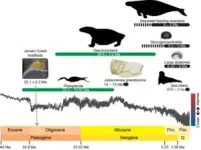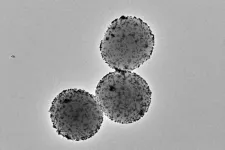(Press-News.org)
Memristive devices constitute a category of devices capable of retaining their internal resistance, thus offering superior performance compared to conventional devices that use integrated circuits. Several materials have been explored to manufacture these devices. In recent years, transition metal oxides have gradually become widely popular for this purpose.
Due to their increasing application in diverse domains like artificial intelligence systems, memristive devices must now overcome several issues related to data retention, endurance, and a large number of conductance states. Moreover, the individual fabrication of these devices is time-consuming. As a result, several challenges need to be addressed to improve their performance and reliability.
In a recent study led by Professor Min Kyu Yang from Sahmyook University, Korea, researchers have developed a silver (Ag)-dispersive chalcogenide thin film for use as a resistance-switching material in memristive devices. Their paper was made available online on October 27, 2023, and published in Volume 664 of the journal Applied Surface Science on January 30, 2024.
The proposed thin film facilitates an “electro-forming-free” process (it does not require an electric current to induce chemical change before manufacture or operation), allowing low-power operation via formation of an active layer. According to Prof. Yang: “Our diffusive Ag-based memristive device in a chalcogenide thin film shows low power consumption and mimics the human brain’s parallel processing. This makes it suitable for implementation in crossbar arrays, and it achieved ~ 92% recognition rate in the MNIST (Modified National Institute of Standards and Technology) handwritten digit recognition database.”
In this study, the researchers utilized a multitude of spectroscopic techniques to characterize the film material, including high-resolution transmission electron microscopy, X-ray photoelectron spectroscopy, Auger electron spectroscopy, and Rutherford backscattering spectroscopy. The team also analyzed various electrodes and resistive switching layers to reveal the significant role played by the Ag atom.
The device demonstrated both state retention and reliable endurance even in a challenging environment of 85 ℃ for 2 hours. This study thus emphasizes the capability of chalcogenide materials to enhance the performance of memristive devices.
The present technology is expected to address the need to increase the memory capacity of semiconductors for big data applications, where the terabyte unit of storage is now considered inadequate. However, this poses the challenge of managing a large volume of chips. Consequently, the “neuromorphic chip” is being developed as the next-generation semiconductor for artificial intelligence systems. These chips need to possess characteristics like low power consumption, compact size, and the capability to analyze human behavior patterns.
“Employing the diffusive Ag-based memristive device structures could lead to the development of neuromorphic chips that could find extensive applications in the Fourth Industrial Revolution markets, including data analysis, speech recognition, facial recognition, autonomous vehicles, and the Internet of Things, as well as contributing to the ongoing 5G communication revolution,” envisions Prof. Yang.
In the long term, the power consumption of these memristive devices could be suitable for applications in modeling of biological synapses in the human brain. Featuring electro-forming-free operation and low-power consumption, they are promising candidates for future nonvolatile memory and artificial synaptic devices.
***
Reference
DOI: https://doi.org/10.1016/j.apsusc.2023.158747
About the institute
Sahmyook University is a private, Christian, institution situated in Nowon-gu, Seoul, South Korea, and is a part of the global network of Seventh-day Adventist higher education institutions. Established in 1906 as Euimyung College in Sunahn, Pyeongan-namdo, which is now part of North Korea, the university has evolved into the largest educational institution affiliated with the Seventh-day Adventist Church. As of 2016, Sahmyook University comprises six colleges, encompassing areas such as Theology, Humanities & Social Sciences, Health Sciences & Social Welfare, along with four graduate schools.
Website: https://www.syu.ac.kr/eng/
About the author
Min Kyu Yang is a professor in the Division of Artificial Intelligence Convergence at Sahmyook University. His research group is dedicated to the development of artificial synapses and artificial neuron devices applicable to neuromorphic computing. Before joining Sahmyook University, he worked at Samsung Electronics. He earned his Ph.D. in Electrical and Electronic Engineering from Yonsei University in 2011.
END
Three decades of data have informed a new Nebraska-led study that shows how the depletion of groundwater — the same that many farmers rely on for irrigation — can threaten food production amid drought and drier climes.
The study found that, due in part to the challenges of extracting groundwater, an aquifer’s depletion can curb crop yields even when it appears saturated enough to continue meeting the demands of irrigation. Those agricultural losses escalate as an aquifer dwindles, the researchers reported, so that its ...
Two teams from UNIL and EPFL have succeeded in demonstrating that the insect synthesizes nutrients for native gut microbes. A study published in « Nature Microbiology ».
Bacteria have adapted to all terrestrial environments. Some have evolved to survive in the gut of animals, where they play an important role for their host; they provide energy by degrading indigestible food, they train and regulate the immune system, they protect against invasion by pathogenic bacteria, and they synthesize neuroactive molecules that regulate the behavior and cognition of their host.
These are great ...
Researchers have developed a platform that combines automated experiments with AI to predict how chemicals will react with one another, which could accelerate the design process for new drugs.
Predicting how molecules will react is vital for the discovery and manufacture of new pharmaceuticals, but historically this has been a trial-and-error process, and the reactions often fail. To predict how molecules will react, chemists usually simulate electrons and atoms in simplified models, a process which is computationally expensive and often inaccurate.
Now, researchers from the University of Cambridge ...
Textbook models will need to be re-drawn after a team of researchers found that water molecules at the surface of salt water are organised differently than previously thought.
Many important reactions related to climate and environmental processes take place where water molecules interface with air. For example, the evaporation of ocean water plays an important role in atmospheric chemistry and climate science. Understanding these reactions is crucial to efforts to mitigate the human effect on our planet.
The distribution of ions at the interface of air and water can affect atmospheric processes. However, a precise understanding of ...
Over the last decades, air pollution emissions have decreased substantially; however, the magnitude of the change varies by demographics, according to a new study by Columbia University Mailman School of Public Health. The results indicate there are racial/ethnic and socioeconomic disparities in air pollution emissions reductions, particularly in the industry and energy generation sectors. The findings are published in the journal Nature Communications.
The research provides a national investigation of air pollution emission changes in the 40 years following the enactment of the Clean Air ...
The chromosomes of American and Chinese chestnut are not so similar after all, at least in one key region of the genome – the nucleolus organizing region (NOR).
The finding, published in a forthcoming article in Scientific Reports, has major implications for anyone with the goal of conferring blight-resistance to American chestnuts through hybridization with the Chinese chestnut.
“This is an unprecedented finding in the field of plant cytology,” says Nurul Faridi, a Forest Service geneticist and lead author of the study.
Traditional ...
New findings debunk previous wisdom that solid-state qubits need to be super dilute in an ultra-clean material to achieve long lifetimes. Instead, cram lots of rare-earth ions into a crystal and some will form pairs that act as highly coherent qubits, shows paper in Nature Physics.
Clean lines and minimalism, or vintage shabby chic? It turns out that the same trends that occupy the world of interior design are important when it comes to designing the building blocks of quantum computers.
How to make qubits that retain their quantum information long enough to be useful is one of the major barriers to practical quantum computing. It’s widely accepted that the ...
Bladder cancer has one of the highest incidence rates in the world and ranks as the fourth most common tumour in men. Despite its relatively low mortality rate, nearly half of bladder tumours resurface within 5 years, requiring ongoing patient monitoring. Frequent hospital visits and the need for repeat treatments contribute to making this type of cancer one of the most expensive to cure.
While current treatments involving direct drug administration into the bladder show good survival rates, their therapeutic efficacy remains low. A promising alternative involves the use of nanoparticles capable of delivering therapeutic agents directly to the tumour. ...
New research has cracked a vital process in the creation of a unique rock type from the Moon. The discovery explains its signature composition and very presence on the lunar surface at all, unravelling a mystery which has long eluded scientists.
The study, published today in Nature Geoscience, reveals a key step in the genesis of these distinctive magmas. A combination of high temperature laboratory experiments using molten rocks, together with sophisticated isotopic analyses of lunar samples, identify a critical reaction that controls their composition.
This reaction took place in the deep lunar interior some three and a half ...
Worldwide, an estimated, 40 million people live with HIV. Two-thirds of this group on the African continent. In 2022, more than 600,000 people died from HIV-related causes and more than 1.3 million were infected. There is no vaccine against the world's second most deadly infection, after TB. Thanks to a grant from the Bill & Melinda Gates Foundation, Amsterdam UMC's Rogier Sanders leads a project that aims to develop the first effective HIV vaccine.
"We hope to be able ...








